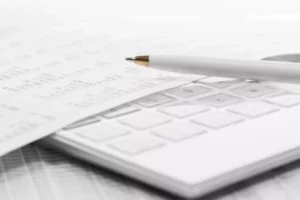Writing paper checks used to be popular a few decades ago. Today, most people prefer managing their finances online. Moreover, it’s much easier to use electronic checks instead of paper ones. The statistics show that around 55% of US citizens prefer paying bills online, and more than 90% get paid via direct deposits.
However, to set up these transaction types, one may need to provide a voided check. Keep reading the article to learn more about the topic. The readers will find out how to void a check and what are some possible alternatives to set up electronic payments or direct deposits.
The Definition of a Voided Check
It’s easy to recognize a voided check since it has the word “VOID” written across the front of the paper check. Typically, the sign is written in large letters to avoid it being accidentally used. In simple words, a voided check is canceled. A person can’t use it to get money from the deposit account.
If you void a check, you disable it, and it won’t work as a blank check. Suppose a thief steals this voided check. The thief won’t be able to write some amount of money and then use it to get cash.
Companies often require new employees to provide voided checks. They need them to set up direct deposits so the new employee can get their salary. The accountant may ask for details instead of a voided check, but providing one guarantees the absence of mistakes or typos.
The reason why companies never ask for blank checks is obvious — so that employees know their checks aren’t used and spent.
How does a Voided Check Work?
Typically, people ask to provide them with a voided check to get banking information. That way, they can link a deposit account to a bank account. The voided check has critical details necessary to set up payments:
- A bank or credit union.
- A bank account number.
- A routing number (identifies the bank).
If you look at your check, it has numbers printed in magnetic ink. The numbers at the bottom provide all the necessary details to deposit or withdraw funds. So, the check works only to provide necessary financial information.
What Is a Void Check Used for?
The void check provides the requester with the necessary information. You can send it to the requestor via mail without worrying that it will end up in the wrong hands. Even if it will, your money is safe in a bank account. Voided checks are used for several reasons:
- Set up direct deposits. The employer gets the necessary data to link a direct deposit to the employee’s bank account. The employee receives the money directly on their deposit account every payday.
- Automate payments. People can automate their payments instead of paying for regular expenses in person at a financial institution or using online banking. For instance, payments for bills, rent, loans, and other regular expenses are automatically withdrawn from a bank account every month.
- Authorize an employer to a direct deposit to get expense reimbursements.
Undoubtedly, knowing how to void one check is a valuable financial skill that makes life easier. But how do you void a check?
How Do You Void a Check?
Voiding a check is an easy task. You will need a checkbook and a pen (blue or black ink). You won’t need any bank services to complete the task. Here’s a step-by-step guide:
- Take a check.
- Write “VOID” in big letters across the front of the check. Instead of writing in huge letters, you may write “void” in smaller letters on the payee line, amount line, dateline, signature line, and in the amount box.
- Make a copy of this voided check to keep it in your records. Consider noting the check number to add it to your register (if you maintain one).
That’s it. No one can ever use the check to write an amount of money and sign it. However, ensure you don’t cover up the routing or bank account number at the bottom of the document. This data is required to identify the bank account to transfer or receive payments. If you cover those numbers, the check becomes useless.
Note: don’t use a pencil to write “VOID” on the check. It’s recommended to use a pen or even a thick marker. You should ensure no one can erase the ink from the check and use it to cash out or deposit into an account.
Moreover, companies often request a copy of the voided check instead of the original. It’s better to send a copy of the check if the requesting company doesn’t mind. The copy could work as an additional security measure.
What Are the Reasons to Void a Check?
Some of the reasons to void a check have already been mentioned. But you should also know that businesses can benefit a lot from setting up direct deposit payments. A business owner may set up electronic payments if vendors prefer receiving their money electronically. In that case, the business should request a void check.
But there is one more reason to void a check — when making a typo or mistake. In that case, the person writing the check should void it. The most common mistake is writing the wrong amount to cash out.
Note: you can’t void a check after giving it to the payee. There is still a way to stop the check from being cashed or deposited into a bank account. Contact your bank immediately and request a stop payment from the bank. This service typically involves a fee.
What Are the Alternatives to Void Checks?
Typically, people use voided checks since they facilitate authorization for setting up direct deposits. Using this document is also the easiest way to set up autopay for recurring payments.
However, if the person doesn’t want to sacrifice one check to provide someone with the information they can pass without a check, they may use an alternative. Moreover, some people don’t have the never-ending supply of paper checks at their disposal.
Instead of voiding a paper check, consider the following alternatives:
- Use a direct deposit authorization form. Instead of sending a copy of a void check, fill out the simple form and send it instead. However, be very careful when filling out financial information. The reason why people prefer voided checks is to avoid mistakes they make when filling out authorization forms. Double-check the bank’s routing number and your account number before submitting the form.
- Use avoided counter-check. What is a counter-check? It’s a blank paper check almost identical to the temporary or starter checks that bank users may receive when they open their bank accounts. Consult your bank to verify if they issue counter-checks. If the institution issues this type of document, then request it from a teller at any bank office. They are called “counter” because a user gets one at a teller’s window or counter.
- Use a deposit slip with banking data preprinted on it. Take a look at your supply of checks. They might include printed deposit slips bound into the stack under the checks.
- Use a check’s or deposit slip’s copy.
If an employer or financial institution asks for a voided check, consider asking if they accept the alternatives mentioned above.


















